 This article describes the odd glyph that resembles the number “4” (EVA-q). It’s odd because the “4” shape wasn’t prevalent in the late 1300s and early 1400s. It was a transitional period when many scribes were still using a character that looks like EVA-l to represent the number 4 and a few were still using Roman numerals.
This article describes the odd glyph that resembles the number “4” (EVA-q). It’s odd because the “4” shape wasn’t prevalent in the late 1300s and early 1400s. It was a transitional period when many scribes were still using a character that looks like EVA-l to represent the number 4 and a few were still using Roman numerals.
That’s not to say that the VMS “4” is a numeral, I’m simply pointing out that this particular shape, with a sharp angled corner, wasn’t a common choice to represent a letter or a number when the VMS was created. Nevertheless, I believe it has its roots in Latin.
[Note: This is the more complete version of some images and commentary I posted on the Voynich.ninja forum a few months ago describing the glyph known as EVA-q. Even this is not the complete story, as there are statistics to go with the images, but it’s far too much information for one blog, so this article focuses on possible origins of the shape.}
How 4 Manifests in the VMS
The 4 glyph makes its first appearance on folio 1v, and from that point is frequently at the beginning of word-tokens and is followed by “o” about 90% of the time. The VMS is so regular in its construction, it would be tempting to think the other 10% are transcription errors, but the 4 has some interesting properties that suggest these are choices rather than errors. But first, here are some examples of the 4o combination, since it is most prevalent. Note that it is usually at the beginnings of Vwords.
But not always, a 4o can show up in the middle or at the end.

 It’s often assumed that “4o” functions as a unit (and perhaps it does), but 4 is not always accompanied by “o”. The following examples show that 4 can be followed by other glyphs, such as a “c” shape, a “c” with a tail, a bench character, a benched gallows character, or the “cap” that represents missing letters in Latin. As further examples, the 4 can also be followed by a benched gallows (f103v) or an “i” (f106r), and 4o itself can be followed by “o”.
It’s often assumed that “4o” functions as a unit (and perhaps it does), but 4 is not always accompanied by “o”. The following examples show that 4 can be followed by other glyphs, such as a “c” shape, a “c” with a tail, a bench character, a benched gallows character, or the “cap” that represents missing letters in Latin. As further examples, the 4 can also be followed by a benched gallows (f103v) or an “i” (f106r), and 4o itself can be followed by “o”.
Both 4o and 4’o can stand alone—they don’t have to be attached to other Vwords. Note also, in the above and below examples, that a Latin abbreviation mark is sometimes associated with 4o. In the above example, the symbol is curved, but it is sometimes written as a straight macron-shape rather than a curved one, and occasionally there is a mysterious extra line connecting the two glyphs (might this be a hidden macron, or a combination with a different meaning?).
 Whether two different abbreviation symbols have the same or different meanings depends on the scribe. Some were quite precise in the way they represented missing letters, others used whatever was convenient to the hand (or their imaginations).
Whether two different abbreviation symbols have the same or different meanings depends on the scribe. Some were quite precise in the way they represented missing letters, others used whatever was convenient to the hand (or their imaginations).
The 4 is frequently followed by “o” (at the beginnings of Vwords), but they are not necessarily a combination—”o” sometimes precedes 4, or is sometimes combined with another 4o.
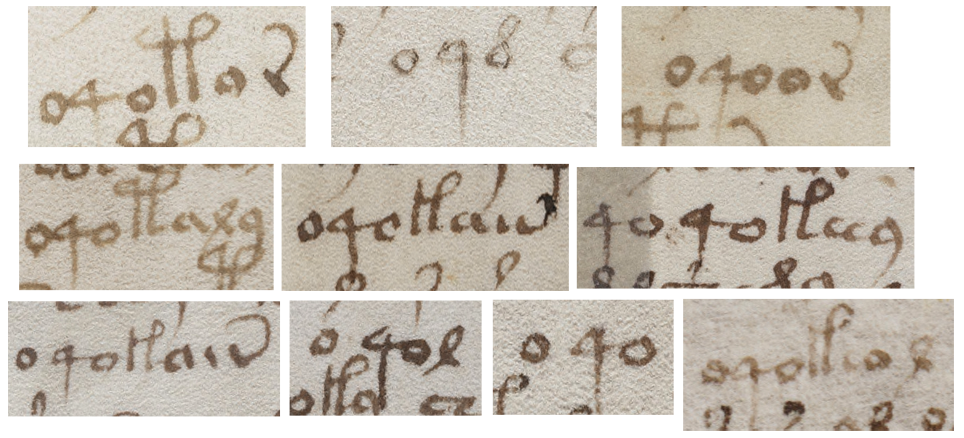 A “4” By Other Names
A “4” By Other Names
This glyph is often called “q” because some have interpreted “4o” as “qu” (it is also mapped to “q” on the EVA system but this keyboard position was not intended to impose meaning on the glyph). Sometimes the 4-shape has a soft connection rather than an angular one, making it look more like “q” than a “4”. Note that the pic on the right has a sharp-angled “4” on the same line as a soft “4”. Sometimes it’s indistinguishable from a “q” (assuming this is EVA-q and not EVA-y—sometimes it’s hard to tell).
There is more than one way to interpret the variation in the loop of the “4” glyph. Perhaps the soft-4 and the sharp-4 have different meanings, or perhaps they don’t, just as a “p” sometimes has a loop that connects and sometimes doesn’t, but means the same thing.
There is more than one character directly associated with 4. Sometimes the 4 is attached to a glyph that resembles the letter ell or the Latin “-is” abbreviation. This combination strongly resembles a mini-gallows character with a descender. The resemblance is so strong, you have to wonder if there’s a connection between EVA-q + “-is” and EVA-k, either in terms of glyph origins or meaning. Or is this a way to hide two consecutive gallows characters? It’s hard to test an uncommon combination—there aren’t enough instances to know if it behaves in the same way as 4o.
Common Patterns
When 4 is combined with o, it frequently precedes a gallows character and the gallows character frequently precedes a or c shapes. I’ve described this rule-like characteristic of Voynichese in past blogs.
Note that 4o is usually in front of the H-like gallows, not the P-like gallows. Note also that some of these are soft-4 and some sharp-4 and yet, at least superficially, they appear to behave in the same way.
Interpretation
If the VMS were Latin, then 4’o (4 and o with a straight or curved macron) can be interpreted in a number of ways—there’s no specific rule for how to expand the abbreviation symbol and there was quite a bit of variation in how scribes drew these squiggles, curves, and lines, but there were some general guidelines.
For example, a “squiggle” like the one found on the first page of the VMS is often interpreted as “er”, “ir”, “re” or “ri”, but even this symbol is sometimes used for other letters. Thus, in a medieval manuscript, one would look at neighboring words (in this case talis and est) to determine whether q’o represents “quero”, “quo”, “questo”, or “quomodo”.
 You might also notice in this example of 15th-century cursive that the “q” shape isn’t round, it’s quite angular, almost like a VMS 4, but it was less frequently written this way.
You might also notice in this example of 15th-century cursive that the “q” shape isn’t round, it’s quite angular, almost like a VMS 4, but it was less frequently written this way.
Does This Mean the Voynich Manuscript is Latin?
Many have tried to translate it as such, it’s one of the most commonly claimed languages in VMS history, but most attempts range from shaky to bad, and sometimes they are really bad (I’ve only seen one that strikes me as a reasonable effort and that’s the one by Yulia May). So far, we only know that the glyphs are Latin, not that the language was Latin. Latin scribal conventions were common to many languages, including Greek, French, Spanish, German, Italian, English, Bohemian, and Scandinavian. The shapes by themselves do not reveal the language—they are adapted to represent common linguistic patterns in that language. Thus, a sign that means “-us” in Latin could potentially be used to represent “-en” or some other common ending in German.
In fact, we still use this system in English. The letter “w” with a line over it or a swooped-back tail is an abbreviation for “with” in the same way that an “a” with a swooped-back tail represents “aut” or “autem” in Latin.
So Where Did the 4 Shape Originate?
It’s possible that the VMS 4 is simply an invention, that no particular precedent inspired the shape. Or maybe the idea came from noticing quirks in the handwriting of certain scribes. As an example of how the “p” was sometimes written in medieval times, notice how the loop in this example is almost completely disconnected from the stem—it almost looks like 4o.
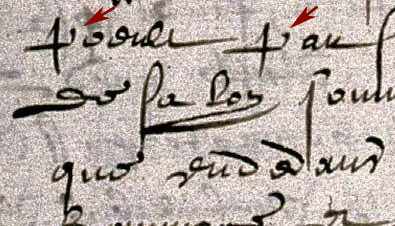 It’s tempting to think this might have twigged the idea for the VMS 4 glyph but, based on the way the abbreviations symbols are associated with 4o, I suspect the true inspiration might be another Latin abbreviation.
It’s tempting to think this might have twigged the idea for the VMS 4 glyph but, based on the way the abbreviations symbols are associated with 4o, I suspect the true inspiration might be another Latin abbreviation.
The 4 Glyph With and Without Ascenders
Note how the following VMS glyph resembles a 4 and appears to behave as a 4 when it precedes an o, but has an extra-long ascender-like stem. The VMS scribes were clearly familiar with Latin scribal conventions, but one still needs to consider whether this is scribal habit, a purely physical error, or a letter that started out as a gallows and got changed to 4. If it is a slip from Voynichese to regular Latin, does it reveal something about the glyph?
Unfortunately, there aren’t enough instances of the ascender4 to know, but we can take a look at other scripts to see if the shape was extant.
Historical Precedents
The VMS ascender4 reminded me of a sample of Visigothic text that includes a number of Latin abbreviations.
- First note the macron in the shape of an old-style four (it looks like an x with a loop on top) near the end of line seven. It’s basically the same shape as EVA-l.
- There is also a q with a long s-curve crossing the stem on the ninth line that can stand for various words including “quo”. A similar convention when applied to a p can turn it into “pre” or “pro” depending on whether the line is straight or curved.
- There is a shape on the bottom that resembles a backwards gallows P that has various meanings depending on the time period. It can mean -us or -rum and is sometimes similar to a pilcrow except that it marks the end of a paragraph rather than the beginning.
- There is an ampersand on line six near the beginning that can stand for “et” (as in Latin “and”) or for the two letters e and t if used as a ligature.
These are all common abbreviations. But the one of particular interest, circled in red, is one that matches the shape of the VMS ascender4. It can be attached to many different letters and is usually at the ends of words.
This character is comprised of a c-shape that loops over a long vertical stem. The loop is sometimes sharp, like a 4, or soft, like a q. The sharpness of the loop does not change the meaning of the symbol. Here it is primarily attached to “q” or “l” but it can be used in many different ways.
Typically the shape represents “-us” (which eventually evolved into a “9” shape or an apostrophe in later medieval manuscripts), but it can stand for other common endings that can be discerned by context, including “-uibus”. If it has a small extra loop on the top right, it can also mean “per” (which was later written by placing a line through the stem of a p rather than extending the top).
It’s possible this abbreviation inspired the shape for the VMS ascender4 and possibly also the 4.
Assuming there is meaning behind the VMS text, this symbol could potentially be expanded into a variety of letter patterns. In Latin it typically represents an ending, but it could just as easily be used as a prefix. Or, alternately, perhaps it does represent an ending and Voynichese is read right to left, even though it has been written left to right. Whenever I examine the text, I always try to scan it in both directions and not make too many assumptions about direction.
Summary
Taken individually, it would be difficult to determine the exact origin of a glyph, but when the VMS characters are studied as a whole, a strong pattern of Latin letters and abbreviations emerges. I haven’t had time to write up all the glyphs yet, I’m adding them as I can make time, but I have found abbreviation origins for almost all of the more peculiar-looking glyphs—and they trace back to Greco-Roman scribal conventions.
I don’t know if the ascender4 is based on the abbreviation-glyph illustrated above (or even if ascender4 and 4 are related), but it might be, so I thought it worth providing an example. If it is, then there’s still the challenge of figuring out whether the shape is simply a shape, a character (alpha or numeric), or something intended to be expanded into additional letters.
J.K. Petersen
© Copyright 2017 J.K. Petersen, All Rights Reserved

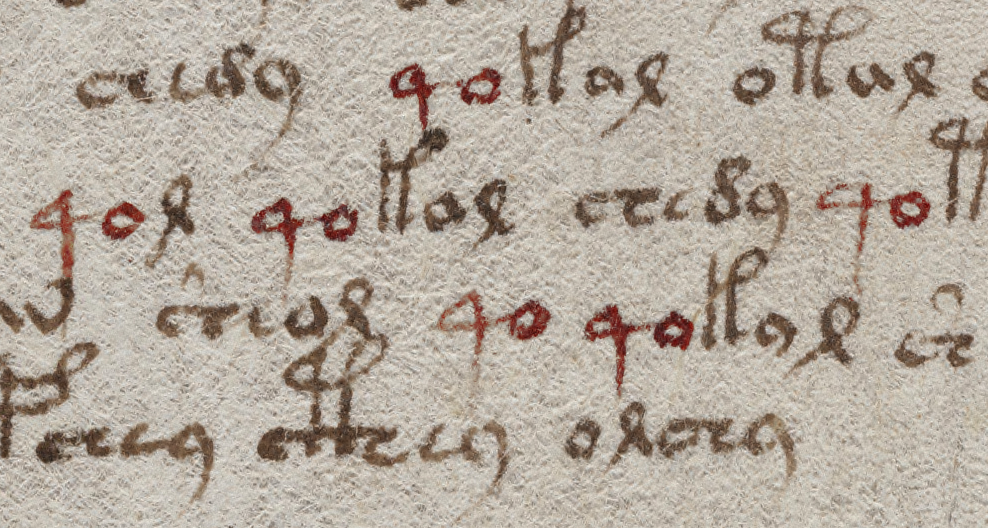



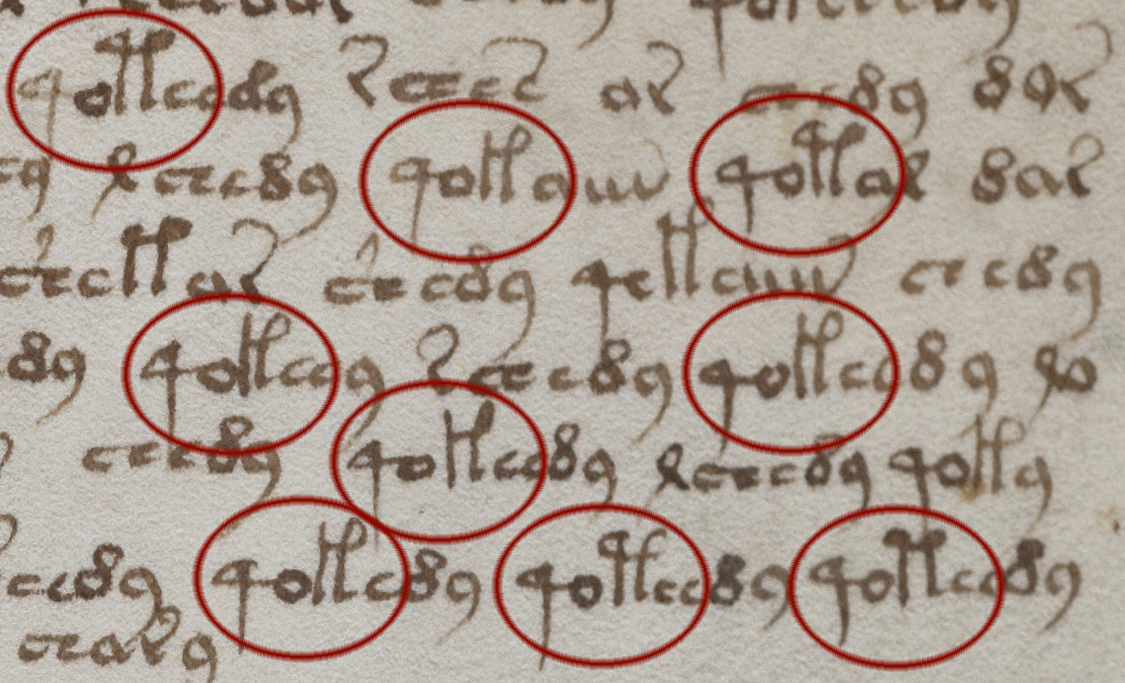
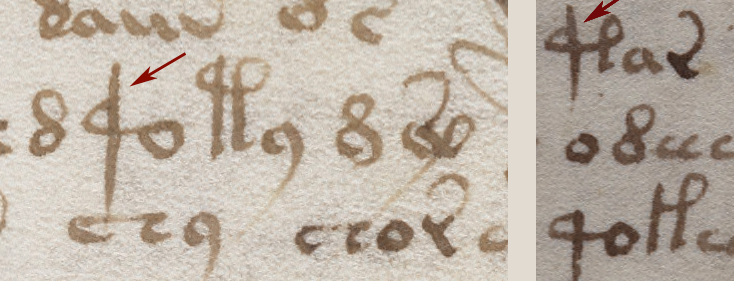
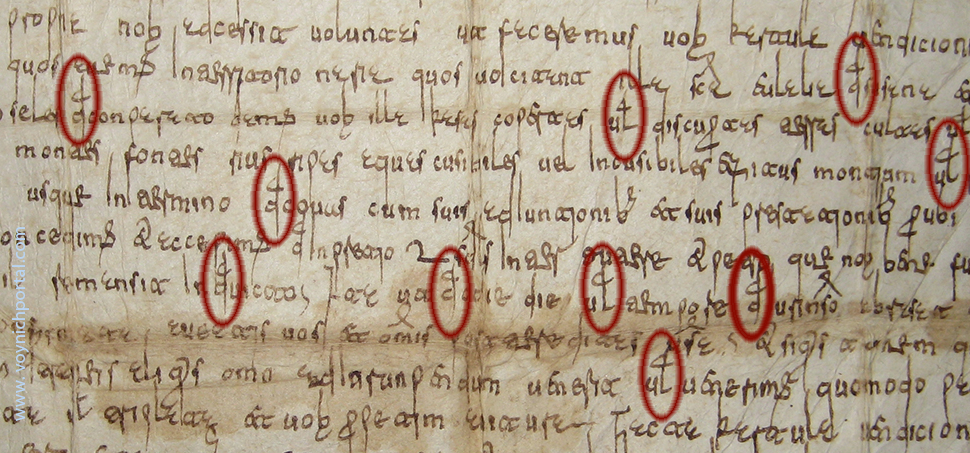
4o appears in a number of non-Arabic-numeral-based cipher alphabets: I listed four of these in “Curse of the Voynich”, dating from 1440 to 1456. In the earliest of these (Leonello d’Este), 4o enciphers ‘quo’: 4o also appears in ciphers used right at the heart of the Sforza court (Tristano Sforza’s cipher key).
Personally, I think it not unlikely that 4o could well have enjoyed a previous life as a 14th century legal abbreviation (e.g. for ‘quo’ etc), but – having fallen out of mainstream use by 1450 – was then revived as a nice-looking cipher shape.
I came up with the idea that the author could have started with words that read, for example
MANner, Man, mantric, and after a while, to give the reader a clue or to simply provide a diversion, created a token that the reader could understand, for example
TANner, Tan, tantric. The reader would be amused, nevertheless, he/she could be able to read the latter words as if they were the former.
If the MS shows words of similar endings at the beginning that have counterparts later in the text,then this idea wouldn’t be so farfetched.
Hi JKP,
do you please have a link to the page containing the “qo talis est” detail? I find the triple repetition interesting….
It’s from a page of pen tests (I think it was in one of the BAV Pal. Lat manuscripts), so the repetition is not unusual in that context, but I will get a link for you later today when I have access to my files so you can evaluate it for yourself.
In the meantime, I thought this example of repetition was interesting… it’s in ÖAW Cod. 1842 on folio 114v, a repetition of the abbreviation for Halleluja:
I couldn’t help thinking when I saw it that All’a would be easy to “encode” in Voynichese.
Marco, I’m sorry it took so long to find the source of the pen test you requested.
In the early days I collected thousands of samples without recording their shelfmarks. I didn’t know I was going to be blogging about the VMS, I was simply trying to expand my knowledge of scribal conventions.
I finally located the original source: Vatican Pal. Lat. 739.